Calatheas
BackCalatheas have incredibly beautiful leaves making them very popular as indoor plants. They’re commonly referred to as the peacock plant due to their distinct leaf markings which can resemble peacock feathers. Although we also think it’s because they like to show off their stunning leaves and rightly so!
Some calatheas are also known for folding their leaves up at night, much like hands in a prayer pose. It is thought to be a mechanism to help keep water off their leaves, allowing them to stay dry and therefore be less susceptible to diseases. It’s just another quirky trait that makes calatheas such interesting plants to grow.
How to Grow Calatheas
Calatheas are mostly forest floor dwellers, so they’re well adapted to growing in low to medium light. Position them in brightly lit rooms but keep out of direct sunlight. Some species will be able to handle the gentle morning sun but definitely avoid the harsh afternoon light as leaves will easily burn. Avoid positioning them anywhere that will get regular cold draughts.
Use a premium potting mix to pot your plant into a pot one size larger which will allow room for growth. Water in with OCP eco-seaweed to help reduce transplant shock.
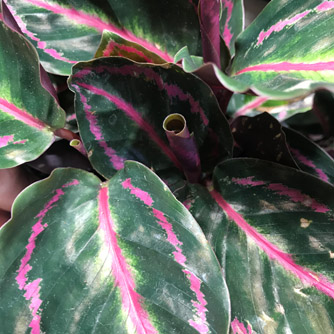
Calathea roseopicta 'Illustris'
Calatheas like their soil to be kept evenly moist. This means they shouldn’t completely dry out but nor should their soil be sopping wet all the time. To keep them happy, it’s best to water when the top 5cm of soil has dried out and water enough so that water runs out the base. Empty excess water from saucers afterwards otherwise you can get issues with root rot. If the soil dries out completely you’ll find that the leaves will either go limp or stay rolled up. Use OCP eco-hydrate to improve water penetration in the potting mix and speed plant recovery. The leaves will perk up over the next couple of days.
Calatheas thrive in medium to high humidity. While some will tolerate lower levels your plants will look best if you mist the leaves regularly or sit the plants on top of a saucer filled with water and pebbles. Calathea ‘White Fusion’ and Calathea orbifolia are particular divas when it comes to humidity, so ensure the humidity is constant otherwise brown edges will mark their gorgeous leaves.
Calatheas will grow outdoors in warm, frost-free climates where they look great under the dappled light of a tree or kept in pots as feature plants. Ensure the soil is well-drained and enriched with plenty of compost and organic matter prior to planting. They will need regular watering to prevent them drying out completely.
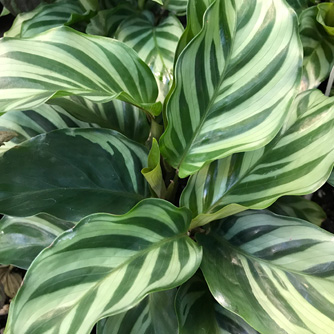
Calathea louisae 'Freddy'
Fertilising and Maintenance of Calatheas
During the warmer months calatheas will appreciate an application of OCP eco-seaweed and OCP eco-aminogro every 2-4 weeks . Apply every 2 weeks if you want to promote faster growth.
As the plant grows, you can repot every 1-2 years in spring. Move up a pot size and use fresh potting mix. Water in with OCP eco-seaweed to reduce transplant shock and help roots establish faster.
You can also use repotting as an opportunity to divide and propagate plants. Remove the plant from the pot and shake off excess mix. Use your hands to gently pry the roots and would-be plants apart. Usually they naturally break off into clumps but if the roots are quite entangled use a sharp knife to separate plants. Ensure there is at least a couple of stems attached to the roots. Pot up all plants into fresh potting mix and water well with eco-seaweed.
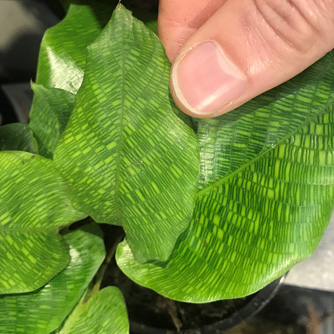
Calathea musaica
Pests and Diseases of Calatheas
Here are a few watch outs:
- Scale – may be found on both sides of foliage or along the stems and can be controlled with a horticultural oil spray.
- Mealybug – this fluffy white pest is often found hiding in tight spots or along the underside of the leaves. Spray thoroughly with OCP eco-neem.
- Mites – the most feared sap-sucking pest, mostly because of its ability to go unnoticed until the damage is quite severe. These tiny critters love calatheas and will cause the foliage to become mottled, speckled silver or faded looking. Spray thoroughly with OCP eco-neem at the first sign of damage.
- Brown leaves – browning edges are a sign of low humidity. To help increase humidity, group plants closer together or place a shallow bowl of water around plants and top up regularly as water evaporates. For serious indoor plant collectors, you may want to invest in a humidifier.
- Fungus gnats – a common pest with indoor plants but that can be controlled by drenching the potting mix with OCP eco-neem. This will kill the juveniles that live in the potting mix and break the lifecycle.
- Leaf and stem rot – this is a clear sign of poor drainage and/or waterlogging. Empty any excess water collecting in the sauces and ensure your potting mix is not overly wet for extended periods of time.
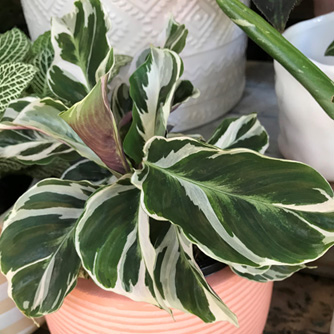
Calathea 'White fusion'
Calathea Varieties
With so many amazing calatheas to grow you’re really spoilt for choice but here are a few to get you excited. Note that some species in the Calathea genus have been reclassified as Geoppertia but are still commonly called calatheas. To help avoid confusion we have mentioned both genera.
Calathea orbifolia (syn. Goeppertia orbifolia) – Large, rotund bright green leaves with silver white stripes. A gorgeous specimen for tropical gardens or indoors with high humidity. Position in bright, indirect light.
Calathea lietzei ‘White Fusion’ – A real collector’s item, with its beautifully patterned green and white marbled leaves and contrasting pink-purple undersides. It requires a humid environment to thrive otherwise the edges will brown. Position in a brightly lit room, out of direct sunlight. While it can tolerate lower light levels, the variegation on the leaves will be reduced.
Calathea lancifolia – The long narrow leaves with wavy margins, symmetrical spots and purple undersides are a real sight, especially when planted as a standalone feature or clumped under a tree. One of the taller species, it can grow up to 60-75cm tall and 60cm wide.
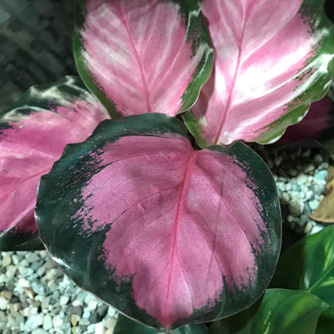
Calathea 'Rosy'
Calathea musaica (syn. Goeppertia kegeljanii) – Sometimes referred to as the ‘network calathea’ due to its interesting network of lines or mosaic patterning on the leaves. It’s a highly sought-after collector’s plant but can sometimes be found floating around in nurseries. Keep your eyes peeled for it!
Calathea makoyana (syn. Goeppertia makoyana) – It may be one of the more common forms as it’s easy to grow, but this seasoned performer knows how to put on a good show. The broad glossy leaves are beautifully patterned with red-purple undersides. It looks fabulous indoors or growing outdoors as a ground cover in tropical gardens.
Calathea zebrina (syn: Goeppertia zebrina) – This species has lush lime-green velvet-sheen leaves striped with bold markings that appear iridescent under bright light. It’s also a tall grower, reaching up to 1m tall and wide. Keep indoors or use outdoors as an understorey plant in tropical gardens.
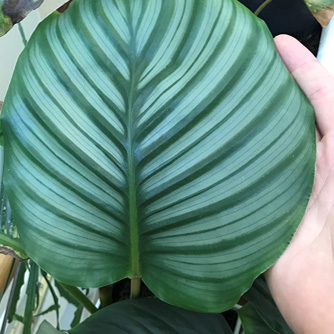
Calathea orbifolia
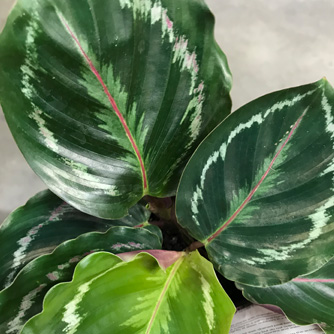
Calathea roseopicta 'Medallion'
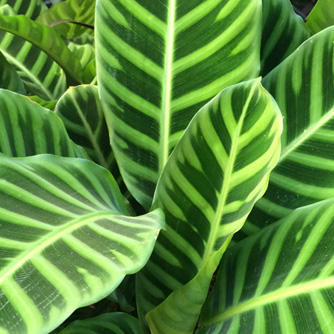
Calathea zebrina


